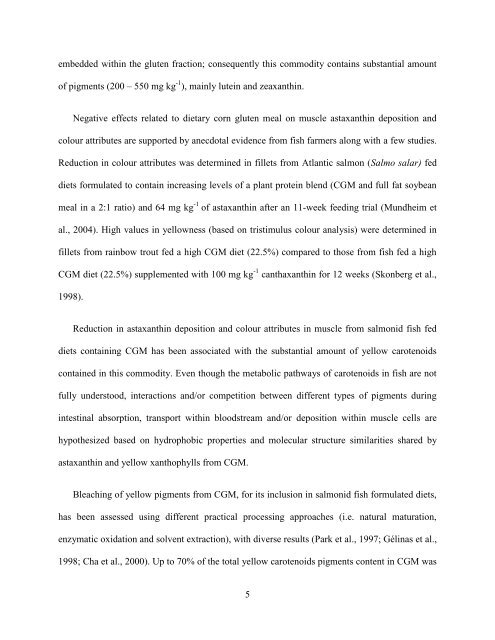Pigment Reduction in Corn Gluten Meal and Its Effects on Muscle ...
Pigment Reduction in Corn Gluten Meal and Its Effects on Muscle ...
Pigment Reduction in Corn Gluten Meal and Its Effects on Muscle ...
You also want an ePaper? Increase the reach of your titles
YUMPU automatically turns print PDFs into web optimized ePapers that Google loves.
embedded with<str<strong>on</strong>g>in</str<strong>on</strong>g> the gluten fracti<strong>on</strong>; c<strong>on</strong>sequently this commodity c<strong>on</strong>ta<str<strong>on</strong>g>in</str<strong>on</strong>g>s substantial amountof pigments (200 – 550 mg kg -1 ), ma<str<strong>on</strong>g>in</str<strong>on</strong>g>ly lute<str<strong>on</strong>g>in</str<strong>on</strong>g> <str<strong>on</strong>g>and</str<strong>on</strong>g> zeaxanth<str<strong>on</strong>g>in</str<strong>on</strong>g>.Negative effects related to dietary corn gluten meal <strong>on</strong> muscle astaxanth<str<strong>on</strong>g>in</str<strong>on</strong>g> depositi<strong>on</strong> <str<strong>on</strong>g>and</str<strong>on</strong>g>colour attributes are supported by anecdotal evidence from fish farmers al<strong>on</strong>g with a few studies.<str<strong>on</strong>g>Reducti<strong>on</strong></str<strong>on</strong>g> <str<strong>on</strong>g>in</str<strong>on</strong>g> colour attributes was determ<str<strong>on</strong>g>in</str<strong>on</strong>g>ed <str<strong>on</strong>g>in</str<strong>on</strong>g> fillets from Atlantic salm<strong>on</strong> (Salmo salar) feddiets formulated to c<strong>on</strong>ta<str<strong>on</strong>g>in</str<strong>on</strong>g> <str<strong>on</strong>g>in</str<strong>on</strong>g>creas<str<strong>on</strong>g>in</str<strong>on</strong>g>g levels of a plant prote<str<strong>on</strong>g>in</str<strong>on</strong>g> blend (CGM <str<strong>on</strong>g>and</str<strong>on</strong>g> full fat soybeanmeal <str<strong>on</strong>g>in</str<strong>on</strong>g> a 2:1 ratio) <str<strong>on</strong>g>and</str<strong>on</strong>g> 64 mg kg -1 of astaxanth<str<strong>on</strong>g>in</str<strong>on</strong>g> after an 11-week feed<str<strong>on</strong>g>in</str<strong>on</strong>g>g trial (Mundheim etal., 2004). High values <str<strong>on</strong>g>in</str<strong>on</strong>g> yellowness (based <strong>on</strong> tristimulus colour analysis) were determ<str<strong>on</strong>g>in</str<strong>on</strong>g>ed <str<strong>on</strong>g>in</str<strong>on</strong>g>fillets from ra<str<strong>on</strong>g>in</str<strong>on</strong>g>bow trout fed a high CGM diet (22.5%) compared to those from fish fed a highCGM diet (22.5%) supplemented with 100 mg kg -1 canthaxanth<str<strong>on</strong>g>in</str<strong>on</strong>g> for 12 weeks (Sk<strong>on</strong>berg et al.,1998).<str<strong>on</strong>g>Reducti<strong>on</strong></str<strong>on</strong>g> <str<strong>on</strong>g>in</str<strong>on</strong>g> astaxanth<str<strong>on</strong>g>in</str<strong>on</strong>g> depositi<strong>on</strong> <str<strong>on</strong>g>and</str<strong>on</strong>g> colour attributes <str<strong>on</strong>g>in</str<strong>on</strong>g> muscle from salm<strong>on</strong>id fish feddiets c<strong>on</strong>ta<str<strong>on</strong>g>in</str<strong>on</strong>g><str<strong>on</strong>g>in</str<strong>on</strong>g>g CGM has been associated with the substantial amount of yellow carotenoidsc<strong>on</strong>ta<str<strong>on</strong>g>in</str<strong>on</strong>g>ed <str<strong>on</strong>g>in</str<strong>on</strong>g> this commodity. Even though the metabolic pathways of carotenoids <str<strong>on</strong>g>in</str<strong>on</strong>g> fish are notfully understood, <str<strong>on</strong>g>in</str<strong>on</strong>g>teracti<strong>on</strong>s <str<strong>on</strong>g>and</str<strong>on</strong>g>/or competiti<strong>on</strong> between different types of pigments dur<str<strong>on</strong>g>in</str<strong>on</strong>g>g<str<strong>on</strong>g>in</str<strong>on</strong>g>test<str<strong>on</strong>g>in</str<strong>on</strong>g>al absorpti<strong>on</strong>, transport with<str<strong>on</strong>g>in</str<strong>on</strong>g> bloodstream <str<strong>on</strong>g>and</str<strong>on</strong>g>/or depositi<strong>on</strong> with<str<strong>on</strong>g>in</str<strong>on</strong>g> muscle cells arehypothesized based <strong>on</strong> hydrophobic properties <str<strong>on</strong>g>and</str<strong>on</strong>g> molecular structure similarities shared byastaxanth<str<strong>on</strong>g>in</str<strong>on</strong>g> <str<strong>on</strong>g>and</str<strong>on</strong>g> yellow xanthophylls from CGM.Bleach<str<strong>on</strong>g>in</str<strong>on</strong>g>g of yellow pigments from CGM, for its <str<strong>on</strong>g>in</str<strong>on</strong>g>clusi<strong>on</strong> <str<strong>on</strong>g>in</str<strong>on</strong>g> salm<strong>on</strong>id fish formulated diets,has been assessed us<str<strong>on</strong>g>in</str<strong>on</strong>g>g different practical process<str<strong>on</strong>g>in</str<strong>on</strong>g>g approaches (i.e. natural maturati<strong>on</strong>,enzymatic oxidati<strong>on</strong> <str<strong>on</strong>g>and</str<strong>on</strong>g> solvent extracti<strong>on</strong>), with diverse results (Park et al., 1997; Gél<str<strong>on</strong>g>in</str<strong>on</strong>g>as et al.,1998; Cha et al., 2000). Up to 70% of the total yellow carotenoids pigments c<strong>on</strong>tent <str<strong>on</strong>g>in</str<strong>on</strong>g> CGM was5
















